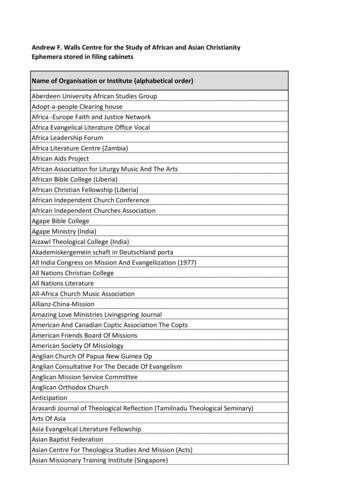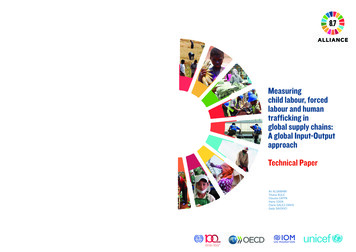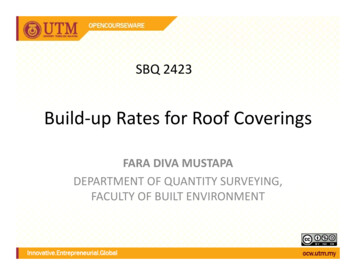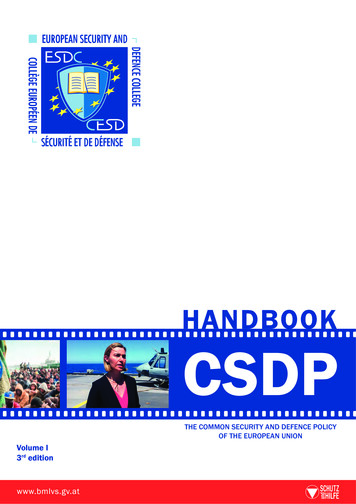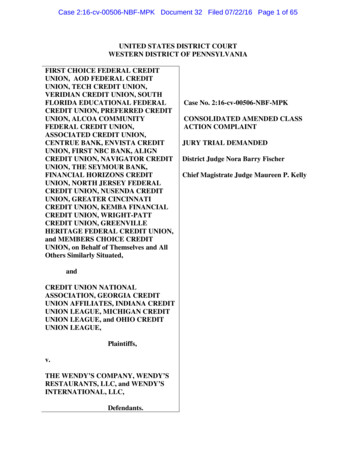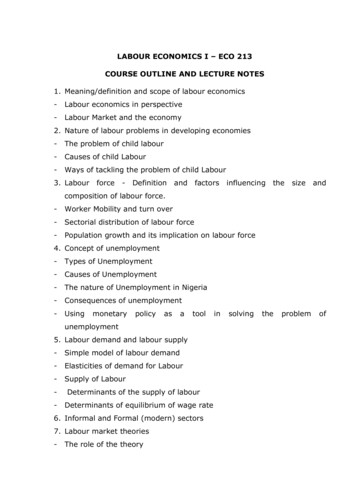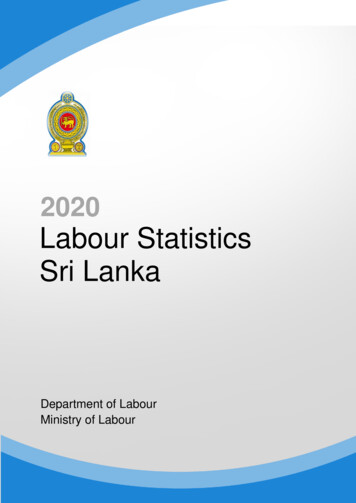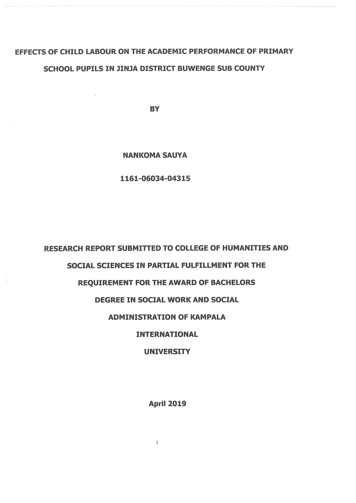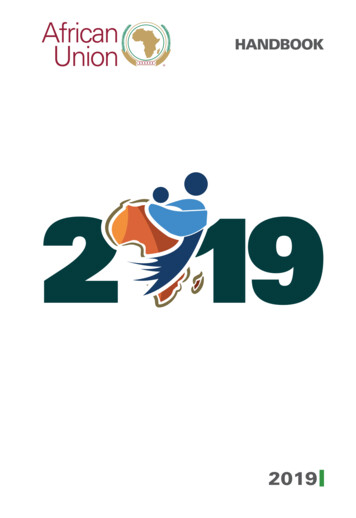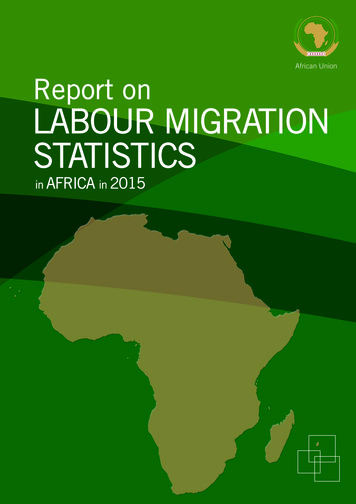
Transcription
African UnionReport onLABOUR MIGRATIONSTATISTICSin AFRICA in 2015
REPORT ON LABOURMIGRATION STATISTICSIN AFRICA IN 2015March 2017African Union Commission (AUC)Addis Ababa, Ethiopia
REPORT ON LABOUR MIGRATION STATISTICS IN AFRICA IN 2015Foreword to the first edition of labour migrationstatistics report in AfricaI am delighted to present the First Edition of the Labour Migration Statics Report in Africa, whichis a landmark in the endeavor of African leaders to make labour migration governance a crucialvector for development in the continent.One of the recurring concerns throughout the continent is the scarcity of disaggregated data oncharacteristics and conditions of labour migrants. This subsequently translates into the inabilityto obtain valid and reliable data describing labour migration and its outcomes, such as stock andnet flow data, longitudinal surveys, assessments of impact on destination and origin countries,and intra-regional remittances and their usage.This 2016 edition contains up-to-date and relatively comparable statistics on labour migration.It is a concrete deliverable of the objectives of the AU-ILO-IOM-ECA Joint Labour MigrationProgramme for Development and Regional Integration, more known as the JLMP, which buildsthe capacity at both national and sub-regional levels to implement labour migration programmesthrough accurate and reliable data on Africa. The goal is to ‘obtain gender and age disaggregateddata on labour migration and migrant workers, including economic activity, employment, workingconditions, skills and educational characteristics, social protection, social security coverage, aswell as on country of origin, migration status, family status, and earnings’. We are confidentlymoving towards fully achieving this goal by 2019.I commend the process undertaken with the first report which allowed National Statistics Officesof about 37 Member States to engage in a cross-learning experience where they steadily workedtowards a common understanding of the concepts, definitions and methodology applied to labourmigration statistics. Indeed, this is an important step which will progressively lead to effectiveharmonization and comparability of labour migration statistics of the African continent over thenext editions. The process also unveiled the real technical obstacles impeding data accuracy andcomparability across regions, sub regions and countries.The report will contribute towards enhancing the capacities of policy makers at national and regionallevel, through an evidence-based approach. The Regional Economic Communities (RECs) will havean initial basis for developing labour migration databases, building on data systems of their MemberStates.I wish to thank all the Member States who have made this production possible by providing thenecessary material and information through their national data, with a commendable attempt tofollow international statistical standards in compiling and reporting data. By showing ownership ofthe whole production process, they guaranteed the reliability of the report to the extent possiblegiven the existing challenges on the continent with data collection.I would also like to express full gratitude to the International Labour Organisation (ILO) - RegionalOffice for Africa for the invaluable assistance on this project. This report would not have beenpossible without its collaboration. The report also benefited from the comments and contributionsof the International Organization for Migration (IOM), United Nations Economic Commission forAfrican (ECA), United Nations Development Programme (UNDP), and the support of EuropeanUnion (EU) and USAID all of whom I also sincerely thank.I encourage all Member States to engage their National Statistics Offices and other entitiesproducing labour migration data in the production of the future editions of the labour MigrationStatistics Report.It is my hope that all stakeholders at all levels will find this publication useful. I am confident thatthe second edition in 2017 will bring us closer to a well-established and recognised publication.H.E Dr. Nkosazana Dlamini Zuma,Chairperson of the African Union Commissioniii
TABLE OF CONTENTSFOREWORD TO THE FIRST LABOUR MIGRATION STATISTICS REPORT IN AFRICAiiiLIST OF FIGURESviLIST OF TABLESviiiLIST OF ACRONYMS AND ABBREVIATIONSxiiEXECUTIVE SUMMARYxiv1 CONTEXT OF LABOUR MIGRATION IN AFRICA1. Political context22. Demographic context33. Overview of Joint Labour Migration Programme (JLMP)32 OBJECTIVES AND METHODOLOGICAL APPROACH OF THE STUDY61. Objectives62. Methodological approach of study72.1 Development of the questionnaire72.2 Designation of focal points72.3 Support of external consultants72.4 The various technical consultation and validation meetings83 PRESENTATION, STRUCTURE AND LIMITATIONS OF THE REPORT101. Presentation of the report102. Report Structure103. Limitations of the report114 CONCEPTS, DEFINITIONS OF THE STUDY5 ASSESSMENT OF DATA QUALITYiv214181. Data sources182. Response Rate18
REPORT ON LABOUR MIGRATION STATISTICS IN AFRICA IN 20153. Data Consistency194. Results on quality of data196 DEMOGRAPHIC PROFILE OF AFRICA221. Population size and Distribution222. Working Age Population243. Labour Force244. Labour Force Participation Rate (LFPR)277 ANALYSIS OF DATA ON MIGRATION IN AFRICA301. General Analysis of Data on Migration in Africa301.1 International Migration301.2 Volume of Migrants301.3 International Migration Rate301.4 Labour Force Participation Rates for International Migrants332. Employment of International Migrants in the RECs342.1 Distribution of total migrants employed between the different RECs342.2 The distribution of international migrants employed in the variousRECs by sex352.3 International migration data analysis within some RECs358 CONCLUSIONS AND EXES57Annex 1: Reference57Annex 2: Classifications on International Labour Migration Statistics58Annex 3: Tables61Annex 4: List of Countries in African Union Commission’s RegionalEconomic Communauties (RECs)106Annex 5: Data Sources108v
LIST OF FIGURESFigure 1: Population of Africa by sex, 2008-201423Figure 2: Population of Africa by REC and sex, 201423Figure 3: Working Age Population (15 ) of Africa by sex, 2008-201425Figure 4: Working Age Population (15 ) of Africa by sex, 2008-201425Figure 5: Labour Force (15 ) of Africa by sex, 2008-201426Figure 6: Labour Force (15 ) by sex and REC, 201426Figure 7: Labour Force Participation Rates in Africa by sex, 2008-201428Figure 8: Labour Force Participation Rates in Africa by sex, 2008-201428Figure 9: International migrants in Africa by sex, 2008-201431Figure 10: International migrants in RECs by sex, 201431Figure 11: International migration rate in Africa by sex, 2008-201432Figure 12: International migration rate in RECs by sex, 201432Figure 13: Labour Force Participation Rate for International migrants from someAfrican countries by sex from different reference years33Figure 14: Stock of international migrants within ECOWAS, 2013-201436Figure 15: Share of stock of migrants in total population for ECOWAS countries in201436Figure 16: Distribution of stocks of international migrants in countries of ECOWASby sex, 201438viFigure 17: Employment rate of international migrants in countries of ECOWASin 2014 (%)38Figure 18: Stock of international migrants in each country (excluding EquatorialGuinea) of ECCAS in 2013 and 201440Figure 19: Employment rate of international migrants in countries of ECCASin 2014 (%)40Figure 20: Distribution of migrants in SADC Countries by sex in 2014 (%)43Figure 21: Employment rate of migrants in countries of SADC in 2014 (%)43Figure 22: Distribution of international employed migrants in SADC countries bysex in 2014 (%)44Figure 23: Proportion of international migrants in the total populations of thecountries of AMU in 2014 (%)44Figure 24: Distribution of international migrants in countries of the AMUby sex in 2014 (%)46Figure 25: Employment rate of migrants in the countries of the AMU in 2014 (%)46
REPORT ON LABOUR MIGRATION STATISTICS IN AFRICA IN 2015Figure 26: Distribution of employed international migrants from AMU by sex in2014 (%)46Figure 27: Proportion of international migrants to total population from differentcountries of the EAC in 2014 (%)48Figure 28: Employment rate of migrants in the countries of the EAC in 201448Figure 29: Distribution of migrant workers in the countries of the EAC by sex in2014 (%)49Figure 30: Stock of migrants in the IGAD countries for the years 2013 and 201449Figure 31: Distribution of migrants by sex in the IGAD countries in 2014 (%)51Figure 32: Employment rate of migrants in the countries of IGAD in 2014 (%)51Figure 33: Distribution of international employed migrants by sex in differentcountries of IGAD (%)52vii
LIST OF TABLESTable 1:Employment rate of international migrants by REC for the years2013 and 2014 (%)34Distribution of employed international migrants in RECs by sexin 201435Distribution of employed migrants in countries of ECOWAS by sex in2014 (%).39Proportion of international migrant stocks in the populations ofECCAS countries in 2014 (%)41Breakdown by sex of the migrant stock in each of the ECCAScountries excluding Equatorial Guinea41Stock of international migrants in the various SADC countriesin 201442Table 7:Stock of international migrants in the countries of the AMU in 201445Table 8:Distribution of international migrants by sex in the EAC countries47Table 9:Proportion of the stock of migrants in the population for the IGADcountries in 2014 (%)50Table A1:Total population by country, 2008-201461Table A2:Male population by country, 2008-201462Table A3:Female population by country, 2008-201464Table A4:Percentage distribution of total population by country, 2008-201465Table A5:Percentage distribution of Male population by country, 2008-201466Table A6:Percentage distribution of Female population by country, 2008-2014 68Table A7:Total population by Regional Economic Community (REC),2008-201469Male population by Regional Economic Community (REC),2008-201470Table A9:Female population by regional economic community, 2008-201471Table A10:Total working age population 15 by country, 2008-201471Table A11:Male working age population 15 by country, 2008-201473Table A12:Female working age population 15 by country, 2008-201474Table A13:Percentage distribution of Total working age population 15 bycountry, 2008-201476Percentage distribution of Male working age population 15 bycountry, 2008-201477Percentage distribution of Female working age population 15 bycountry, 2008-201478Table 2:Table 3:Table 4:Table 5:Table 6:Table A8:Table A14:Table A15:viii
REPORT ON LABOUR MIGRATION STATISTICS IN AFRICA IN 2015Table A16:Total working age population 15 by Regional EconomicCommunity, 2008- 201480Male working age population 15 by Regional EconomicCommunity, 2008-201480Female working age population 15 by Regional EconomicCommunity, 2008-201481Table A19:Total Labour Force 15 by country, 2008-201481Table A20:Male Labour Force 15 by country, 2008-201483Table A21:Female Labour Force 15 by country, 2008-201484Table A22:Labour Force 15 by sex and Regional Economic Community,2008-201485Table A23:Total Labour Force Participation Rate by country, 2008-201486Table A24:Labour Force Participation Rate of Males 15 by country,2008-201488Labour Force Participation Rates of Females 15 by country,2008-201489Labour Force Participation Rates of Females 15 by REC,2008-201490Table A27:Total migrants by country, 2008-201491Table A28:Male migrants by country, 2008-201492Table A29:Female migrants by country, 2008-201494Table A30:Percentage distribution of Total Migrants by country, 2008-201495Table A31:Percentage distribution of male migrants by country, 2008-201496Table A32:Percentage distribution of Female migrants by country, 2008-201498Table A33:Total migrants by Regional Economic Community (REC),2008-201499Male migrants by Regional Economic Community (REC),2008-2014100Female migrants by Regional Economic Community (REC),2008-2014100Table A36:Total international migration rate by country, 2008-2014101Table A37:International male migration rate by country, 2008-2014102Table A38:International female migration rate by country, 2008-2014103Table A39:International migration rate by Sex and Regional EconomicCommunity (REC), 2008-2014105Countries by the sources of data as provided to AUC108Table A17:Table A18:Table A25:Table A26:Table A34:Table A35:Table A5.1:ix
ACKNOWLEDGMENTThis report is a joint product of the AfricanUnion Commission (AUC), the InternationalLabour Organization (ILO), the InternationalOrganization for Migration (IOM) and the UnitedNations Economic Commission for Africa (ECA).The report was prepared by a core team whichwas led by Imani Younoussa, Head, StatisticsDivision, Economic Affairs Department, AUC;Oumar Diop, Department of Social Affairs,AUC;and Yacouba Diallo, Senior Statistician, RegionalOffice for Africa, ILO. The technical team alsoincluded, Samson Nougbodohoue, PhilipBob Jusu, Peter Mudungwe, Theresa WatwiiNdavi (AUC), Honoré Djerma, Coffi Agossou,Hakki Ozel, Aly Cissé, Mariette Sabatier (ILO),Naomi Shirefaw, Sophia Aytenew (IOM), JosephTinfissi Ilboudo, William Muhwava and GideonRutaremwa (ECA). The team also benefittedfrom the technical contributions of the followingconsultants: Dorcas Nabukwasi, Nadia Touihri,Hippolyte Togonou, Pierre N’guessan Dje,Doumbia Saliha, and Firmin Vlavonou.The work was carried out under the supervisionof René N’Guettia Kouassi, Director, EconomicAffairs Department, AUC; Dr. Olawale.I.Maiyegun, Director, Social Affairs, AUC; CynthiaSamuel-Olonjuwon, Deputy Director, RegionalOffice for Africa, ILO. Guidance to the teamwas provided by Anthony Mothae Maruping,Commissioner for Economic Affairs, AUC;Mustapha Sidiki Kaloko, Commissioner forSocial Affairs AUC; and Mr Aeneas ChumaChapinga, Director, Regional Office for Africa(ILO).xThe team undertook wide-ranging consultationswith stakeholders and African experts for thisreport, from conceptualization to the final draft.These consultations included a meeting withRegional Economic Communities (RECs) inAbidjan from 28-29 August 2015 to presenta status-update to RECs on JLMP activities(Joint Labour Migration Programme) andidentify possible areas of support from RECs toNational Statistics Offices (NSOs) in the areasof labour migration statistics. The meetingbrought together the AUC, ILO and the followingRECs: The Community of Sahel-Saharan States(CEN-SAD), East African Community (EAC),Economic Community of West African States(ECOWAS), Economic Community of CentralAfrican States (ECCAS), IntergovernmentalAuthority on Development (IGAD) and SouthernAfrican Development Community (SADC).Representatives from the following organisationwere present: United Nations EconomicCommission for Africa (ECA) and AFRISTAT.The Abidjan consultation was followed byan expert group meeting to validate thedata provided by the countries held from29 September – 1 October 2015 in Addis Ababa,Ethiopia in which the following participants tookpart: Nascimento Sandra Mara (Angola), GiseleHouessou Assaba (Benin), Tebogo Laletsang(Botswana), Sawadogo Soumaïla (BurkinaFaso), Placide Nibogora (Burundi), FélicienFomekong (Cameroon), Lawe NgaïndandjiProsper (Chad), Massoundi Miradji (Comoros),Frédéric Poumbou (Congo), Blaise MwembaMutonji (Dem. Rep. Of Congo), Akoisso DoriaDeza (Cote D’ivoire), Mostafa Younes Yousef
REPORT ON LABOUR MIGRATION STATISTICS IN AFRICA IN 2015Younes (Egypt), , Wally H. Ndow (Gambia,The), Ossei Emmanuel George (Ghana), SayonOulaye (Guinea), Toumane Luntam Graça Baldé(Guinea Bissau), Okelo Caleb Oyuke (Kenya),Makeoane-Phakisi Maneo Lefulesele Anthonia(Lesotho), Daniel F. Kingsley (Liberia), Ali Said(Libya), Chakanza Charles Patrick (Malawi),Daouda Dit Aba Fane (Mali), Marie DesireeCyndy Martial (Mauritus), Jonas GonçalvesNassabe (Mozambique), Elina Sheehama(Namibia), Sani Oumarou (Niger), VincentIfeanyichukwu Oriokpa (Nigeria), Neto Da SilvaBorges Ketty-Keila (Sao Tome and Principe),Abdoulaye Mamadou Tall (Senegal), BurnyLoany Georges Payet (Seychelles), SallieuMansaray (Sierra Leone), Mohamed HusseinAbdullahi (Somaila), Manamela MmatsholangDesiree (South Africa), Mark Odwari (SouthSudan), Somaia Ahmed Hemaidan Idris(Sudan), Hashim Njowele (Tanzania), FankebaSouradji (Togo), Wilson Nyegenye (Uganda),Harriet Namukoko Zimbizi (Zambia), TidingsMatangira (Zimbabwe), Mohamed Mghari(Morocco), Mudubu Leon Konande (ECCAS),Mamadi Kourma (CEN-SAD) and MohammedElduma Abdalla (IGAD).A second validation meeting was organisedwith the aim of validating the first draft of thereport and was held from 30 May-2 June 2016in Dakar, Senegal, with the support of UnitedStates Agency for International Development(USAID), in which the following participantstook part: Gisele Houessou Assaba ( Benin),Fomo Marie Antoinette (Cameroon), RiradjimMadnodji (Chad), , Aka Dore Desire Emanuel(Cote d’Ivoire), Mostafa Younes Yousef Younes(Egypt), Batiso Zerihun Bekele (Ethiopia),Ndow Wally Hadre (The Gambia), OsseiEmmanuel George (Ghana), Okelo Caleb Oyuke(Kenya), Ndawala Jameson Simon (Malawi),Daouda Dit Aba Fane (Mali), Karoona DeviPothegadoo (Mauritius), Elísio Sebastião Mazive(Mozambique), Vincent Ifeanyichukwu Oriokpa(Nigeria), Sandile Elvis Simelane (South Africa),Wilson Nyegenye (Uganda), Tidings Matangira(Zimbabwe), Rwanshote Joseph (IGAD).The report benefited from administrativesupport from Sewnet Mulushoa and Noupeu NjiSara Edith, AUC.xi
LIST OF ACRONYMS AND ABBREVIATIONSAIR:African Institute for RemittancesAMU:Arab Maghreb UnionAU:African UnionAUC:African Union CommissionAU-HOAI: African Union Horn-of –Africa InitiativeCEN-SAD: Community of Sahel-Saharan StatesCOMESA: Common Market for Eastern and Southern AfricaDFID:Department for International DevelopmentEAC:East African CommunityECCAS:Economic Community of Central African StatesECOWAS: Economic Community of West African StatesxiiEU:European UnionICSE:International Classification of Status in Employment.IGAD:Intergovernmental Authority on DevelopmentILMQ:International Labour Migration QuestionnaireILO:International Labour OrganizationIOM:International Organization for MigrationISCED:International Standard Classification of Education
REPORT ON LABOUR MIGRATION STATISTICS IN AFRICA IN 2015ISCO:International Standard Classification of OccupationsISIC:International Standard Industrial ClassificationJLMP:Joint Labour Migration ProgrammeLFPR:Labour Force Participation RateLFS:Labour Force SurveyLMIS:Labour Market Information SystemPHC:Population and Housing CensusQtrly:QuarterlyREC:Regional Economic CommunitySADC:Southern African Development CommunitySDGs:Sustainable Development GoalsUNDESA: United Nations Division for Economic and Social AffairsUNECA:United NationsUNICEF:United Nations Children’s FundEconomic Commission for Africaxiii
EXECUTIVE SUMMARYnn Regional integration and development areamong the strong commitments renewedby Africa leaders at both regional andcontinental levels over the last decade,mainly through bold policy frameworksand legal instruments aiming at increasinggrowth and shared prosperity. Thecommitments cover variousinterrelated fields such as free movementof persons and labour, increased trade andinvestment, infrastructure development,accelerated industrialisation, educationand technical and vocational educationand training (TVET), social security, etc.The AU/ILO/IOM/ECA Joint Programmeon Labour Migration for Integration andDevelopment in Africa is a comprehensiveinitiative articulating strategies around theseinterrelated fields. This initiative aims atspeeding up the flows of migration and inparticular labour migration, throughout thecontinent.nn The data component of the Joint LabourMigration Programme (JLMP) seeksto enhance collection, exchange, andutilization of gender and age disaggregateddata on migrants’ economic activity,employment skills, education, workingconditions and social protection. In orderto achieve this and fill-in the resultingdata gap, questionnaires were sent to all54 African countries whereby focal pointswere to be nominated by national statisticsoffice, in June 2015. From the 54 countries,34 countries responded to the request forxivdata on labour migration, thereby indicatinga response rate of 63 percent.nn Africa’s has grown from 991.2 million in2008 to 1.2 billion in 2014 (JLMP, 2015).This represents a population growth rate of2.6% over the reference period. The findingsalso show that, women outnumbered menduring the reference period. This trend isalso manifested across Regional EconomicCommunities (RECs).nn The working age population comprising of15 years and over also continues to grow.During the 2008-2014 period under review,it grew from 581.2 million people in 2008 to716.1 million people in 2014 (JLMP, 2015).CEN-SAD and ECOWAS recorded thelargest number of persons of working agepopulation, accounting for 313.5 millionand 221.9 million persons in 2014. EAC(62.5 million) and AMU (68.2 million)reportedly had the lowest number of personsof working age population.nn The size of the labour force (employed unemployed) in the continent ranged from383.6 million in 2008 to 455.9 million in2014 (JLMP, 2015). In the same manneras the increase in general populationand working age population witnessedabove, the size of the labour force similarlyincreased over the period 2008-2014 byabout 72.3 million persons. This increaseis also reflected across males, 221.1 million(2008) to 255.7 million (2014) and females,
REPORT ON LABOUR MIGRATION STATISTICS IN AFRICA IN 2015160.8 million (2008) to 200.3 million (2014).COMESA (181.6 million) and CENSAD (174.7 million) were the RECs thataccounted for the largest Labour Force in2014. AMU on the other hand accountedfor the lowest labour force among the RECswith 32.6 million recorded for 2014. Thedecline in the size of the labour force over thereference period is also reflected through thelabour force participation rate (LFPR). LFPRdecreased from 66% in 2008 to 63.7% in2014 for both sexes. It is apparent that thisdecline is in part precipitated by the declinein male LFPR over the period under reviewfrom 76.7% in 2008 to 71.7% in 2014.Out of the 15.9 million migrants in 2014,there were 8.3 million migrant workers(4.7 million males and 3.6 million females)according to the regional estimates fromthe current study. No significant genderdifferentials were observed in the numberof migrants. Most international migrantsresided in CEN-SAD and ECOWAScomprising 7.6 million and 7.1 millionmigrants respectively. The RECs hostingthe least international migrants were AMU(1.1 million) and ECCAS (1.6 million)migrants. CEN-SAD and ECOWAS registeredthe highest international migration rates of2.2% and 2.1% respectively.nn International migration in Africa increasedfrom 13.2 million migrants to 15.9 millionmigrants from 2008 to 2014 (JLMP, 2015).nn International migrants were found tobe relatively more economically activecompared to the general population.xv
CHAPTER1
1CONTEXT OF LABOURMIGRATION IN AFRICA1. Political contextAt continental level, the African Union haselaborated a comprehensive set of migrationpolicy commitments and recommendations,since the Abuja Treaty establishing the AfricanEconomic community (1991). Many of theselargely complementary documents have beenadopted at the Heads of State level. Together,they add up to a comprehensive guidanceframework for national and regional labourmigration policy across the continent. Theyinclude, amongst others, the 2006 AU MigrationPolicy Framework that devotes a main chapterto Labour Migration, the AU Plan of Action onBoosting Intra African Trade (2012) recognizingthe key role of free movement of people andlabour migration regulation, the Joint AfricaEU Declaration on Migration and Development,Tripoli, 22-23 November 2006. The ContinentalFree Trade Area (CFTA) and Boosting Intra-AfricaTrade (BIAT) contribute to integration as well.In July 2015, the AU Assembly adopted thefollowing landmark declaration on migration,“Reaffirm our previous commitments aimedat accelerating mobility and integration onthe continent, migration in development whileaddressing regular and irregular migration”.The Heads of States and Government therefore2committed to: (i) Speed up the implementationof continent-wide visa free regimes includingissuance of visas at ports of entry for Africans;(ii) Offer all Africans the same opportunitiesaccorded to the citizens of countrieswithin our respective Regional EconomicCommunities (RECs) by 2018; (iii) Expeditethe operationalization of the African Passport;(iv) Establish a harmonized mechanism toensure that higher education in Africa iscompatible, comparable, with acceptabilityand enable recognition of credentials that willfacilitate transferability of knowledge, skills andexpertise. At their request, the AUC is developinga Protocol on Mobility and Free Movement ofpeople in Africa.At regional level, the Regional EconomicCommunities have put in place policies and/or legal instruments aiming at facilitatingfree movement of people and promotinglabour migration including provisions on skillsportability and social security benefits portabilityas well.These instruments are intended to increase thelabour migration flows within the continent.
REPORT ON LABOUR MIGRATION STATISTICS IN AFRICA IN 20152. DemographiccontextAfrica is recognized as one of the mostdemographically dynamic continents. Witha population of over one billion with a youngmajority, Africa must absolutely use this labourintensity to accelerate its development. It isnoted that the quality of certain labour intensivejobs differs greatly from country to country.Labour mobility in its totality within Africa haspositioned itself as one of the reliable solutionsto this problem. A well-planned labour mobilitystrategy between African countries could be aneffective way to address the high costs incurredby importing labour from countries mainly fromEurope, Asia and America.The development of a database on labourmigration statistics in Africa should provide atimely response to the economic, demographicand social factors affecting labour migration inAfrica. The database which is the result of thisstudy will also provide an appropriate responseto international calls for multiple data collectionand quantitative analysis in this area. The JLMPdata collected fills in an important knowledgegap for policy makers, businesses, employers,employees and the research community.3. Overview of JointLabour MigrationProgramme (JLMP)For over a decade, the AUC has been engagedin providing policy guidance on Migrationand working closely with its Member States toaddress critical migration issues. The various AUpolicy frameworks and instruments on the issuecontain recommendations on how to promotethe benefits of migration, improve capacity formigration management and enhance mobility onthe continent as well as address the challengesof irregular migration.The Heads of State and Government of Africa attheir 24th Ordinary Session of the AU Assemblyin January 2015, adopted the AUC/ILO/IOM/ECALabour Migration Governance for Developmentand Integration Regional Programme inAfrica, known as the Joint Labour MigrationProgramme (JLMP). It was developed on thebasis of the Migration Policy Framework forAfrica (Banjul 2006). It defines the strategiesunder Priority Area 5 of the AU Plan of Actionon Employment and Poverty Alleviation(Assembly / AU / 20 (XXIV)) adopted in AddisAbaba in January 2015.The objectives and actions in the JLMP aredesigned to meet the challenges of migrationand labour mobility on the continent bystrengthening the capacity of Member States andRECs to, among other things, achieve a greaterdevelopment, adoption and implementationof harmonized systems of free movement andcoherent national migration policies of theworkforce in the RECs. They also aim to extendsocial security to migrants to access compatibleportability systems, resolve “shortages” of skills3
CHAPTER 1 CONTEXT OF LABOUR MIGRATION IN AFRICAand inadequate teaching skills, while increasingrecognition of diplomas harmonized acrossAfrica, fair hiring practices, etc. Facilitation ofmobility and the free movement regimes shouldprovide more channels for legal migration andcontribute to the reduction of irregular migration.The AUC, ILO, IOM and UNECA implement theJoint Programme on Migration of labour (JLMP)for Africa officially adopted in January 2015 bythe Heads of State and Government of Africa4as a global programme on the governance oflabour migration in the region.During the round-table on intra-regionalmigration and mobility of the workforce inAfrica held from 23 to 25 March 2015 in Kigali,Rwanda, a roadmap for the implementation ofthe JLMP was adopted. The data componentincluded in this road map occupies an importantplace due to the objectives assigned to it.
UN/ Jean Pierre LaffontCHAPTER2
2OBJECTIVES ANDMETHODOLOGICALAPPROACH OF THESTUDY1. ObjectivesThe overall stated objective of the JLMP isto: strengthen the effective governance andregulation of labour migration and mobilityin Africa, under the rule of law and withthe involvement of key stakeholders acrossgovernment, legislatures, private sectoremployers, workers (social partners), migrants,international organizations, NGOs and civilsociety organizations.The broad objective of the report is to compiledata on labour migration and support MemberStates in better understanding the data for thepurpose of policy formulation. This work willsupport the successful implementation of the2030 Agenda for Sustainable Development,which includes a target on the protection ofmigrant workers under the goal of promotingdecent work and economic growth. Africa hasembraced both global and continent-widedevelopment frameworks which recognize th
to obtain valid and reliable data describing labour migration and its outcomes, such as stock and net flow data, longitudinal surveys, assessments of impact on destination and origin countries, and intra-regional remittances and their usage. This 2016 edition contains up-to-date and relatively comparable statistics on labour migration.
